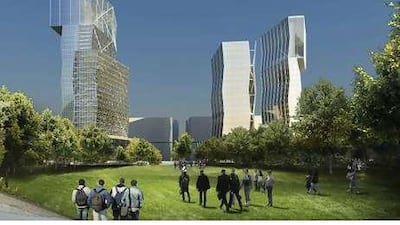PARIS // The peerless Paris skyline dominated by the Eiffel Tower may be transformed in the next few years, now that the city fathers have approved controversial studies for new skyscrapers to rise up around the edge of the French capital. Going upwards is the response of Bertrand Delanoë, the city's Socialist mayor, who must meet demand for social housing and commercial space while respecting the neoclassical architecture that makes Paris one of the most popular tourist destinations.
But Mr Delanoë's reach for the sky is fraught with social, economic and electoral implications, injecting high risk into his plan to move Paris from a theme park of imperial architectural grandeur to a global city of the 21st century. This is also a tale of two cities. Critics of Paris point to London's eclectic collection of new buildings as reflecting an economic and cultural vigour absent from the French capital, whose beauty is fading under rigid urban planning rules. Part of the appeal of Paris is that people live in the centre, giving the city a heartbeat. Small shopkeepers - greengrocers, butchers, fishmongers and independent booksellers - still serve local residents. But with high rents and gentrification, increasingly only the rich can afford to live in Paris.
To meet demand, the town hall has pledged to build 40,000 new housing units over the new mayoral term. Mr Delanoë said towers were the only way. "We have to rethink the extension of Paris," said Anne Demians, an architect whose firm has submitted studies for a two-tower complex in the 13th district. "We have to get out of the Haussmann master plan." Baron Georges-Eugène Haussmann's urban renewal under Napoleon III created a harmonious city of homogenous stone buildings, with broad boulevards, convenient for cavalry charges to clear the streets in case of public uprisings.
Given the density of the city, whose size is limited by a ring road that separates Paris from the near suburbs, any expansion must take place on the edge, Ms Demians said. At city hall's request, her firm has drafted plans for two towers, 150m and 200m in height, linked at three levels. The complex would include flats, businesses and new law courts. Nicolas Sarkozy, the president, meanwhile, has his own ambitions to reinvigorate the capital. In early June, Mr Sarkozy invited architects and planners to deliver designs for forging a Greater Paris. The idea is to integrate the urban centre with surrounding municipalities, which are presently run as separate political fiefdoms.
"The political risk for affluent western suburbs is that they will be forced to spend money on transport and amenities which will benefit poorer constituencies," said Michael Heurtevant, an architect. Another concern arises from the concentration of lower-income families is the massing of potential socialist voters in conservative strongholds, which could redraw the electoral map. In pursuit of Mr Delanoë's drive to modernise, the Socialist majority on the city council last week approved a programme of architectural studies and public consultation for skyscrapers to be built on six sites around the city.
Not since the construction of the Montparnasse tower 30 years ago has a tower been built, Ms Demians said. That signals the boldness of Mr Delanoë's plan, which seeks to break with the past. Building regulations aimed at preserving the skyline have capped heights at 37m, about 10 storeys. Besides the Montparnasse tower, the only exceptions are high-rises in the 15th district along the Seine river. "The consensus is that both those are ugly buildings that deface Paris," Mr Heurtevant said. "We have to find something that works."
The city's plans to put council housing up to 50m, or 15 floors, drew fire from the conservative UMP (Union for a Popular Movement). "These buildings are real time bombs and will blow up in our face any time in the next 15 years," said Jean-François Lamour, president of the UMP. "We will find the same social problems, except worse, at 50m instead of 37m." Sceptics point out that towers alienate people from other people, deny residents access to air and public space.
If local councils are unable to afford to maintain the towers, lifts will fail and lights will go unrepaired, leaving dark passageways, inviting crime and graffiti. Solutions might be to encourage property owners to rent out the vast numbers of flats that go unlet because proprietors complain the law gives excessive tenant protection, or to invest in low-rise housing and pump money into better transportation to the suburbs.
"If Paris does develop along its boundaries, the infrastructure is already there in the form of the RER [the city's urban rail network]. Maybe in 20 years, taking the RER to Clichy sous Bois will be as fashionable as it is to take the subway in New York to Dumbo or Fort Greene in Brooklyn," said James Hicks, a US architect who has lived in Paris. @Email:ptran@thenational.ae

